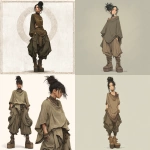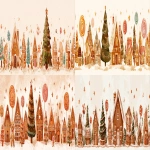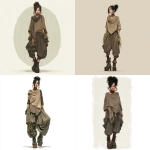Explore the Best AI Image Gallery

A New Canvas: Exploring the Ethical Frontiers of AI-Generated Media
The intersection of artificial intelligence (AI) and creativity is rapidly evolving, giving birth to a new era of media generation. Algorithms can now compose music, write scripts, design visuals, and even craft entire narratives, blurring the lines between human and machine artistry. While this technological advancement presents exciting opportunities, it also raises profound ethical questions that demand careful consideration.
The Transformative Potential of AI-Generated Media
AI-generated media has the potential to revolutionize various sectors within the creative industry:
- Content Creation: AI can assist writers in overcoming writers block, generate diverse storylines, and even personalize content for individual audiences.
- Visual Arts: Algorithms can create stunning visuals, ranging from paintings and sculptures to 3D models and animation, expanding the creative toolkit for artists.
- Music Production: AI can compose original music scores, generate unique sound effects, and even adapt existing melodies to different styles and genres.
- Interactive Experiences: AI can power immersive narratives, dynamic games, and personalized virtual environments, blurring the lines between reality and fiction.
Navigating the Ethical Labyrinth
While the possibilities are vast, it is crucial to navigate the ethical implications of AI-generated media responsibly:
- Authorship and Ownership: When an AI creates a work, who owns the copyright? Establishing clear guidelines for intellectual property rights in the age of AI is essential.
- Bias and Discrimination: AI algorithms are trained on existing data, which can perpetuate societal biases. It is imperative to ensure that AI-generated content does not reinforce harmful stereotypes or discriminate against individuals or groups.
- Transparency and Explainability: The decision-making processes of AI models can be complex and opaque. Promoting transparency in how AI generates content can build trust and accountability.
- Misinformation and Manipulation: AI can be used to create convincing fake news, deepfakes, and other forms of synthetic media. Addressing the potential for misuse and protecting against manipulation is crucial.
- Impact on Human Creativity: While AI can augment human creativity, it is important to consider the potential impact on human artists and designers. Fostering collaboration between humans and AI can lead to more innovative and meaningful creations.
The Future of AI-Generated Media
As AI technology continues to advance, we can expect to see even more transformative applications in the creative industry:
- Personalized Content Experiences: AI will enable the creation of highly personalized content tailored to individual preferences and interests.
- Immersive and Interactive Storytelling: AI-powered narratives will offer deeper levels of immersion and interactivity, blurring the lines between fiction and reality.
- Collaborative Creative Platforms: AI will facilitate collaboration between artists, designers, and developers, fostering new forms of creative expression.
The future of AI-generated media holds immense promise, but it is essential to approach this technological revolution with a thoughtful and ethical lens. By addressing the challenges and harnessing the potential responsibly, we can create a future where AI empowers human creativity and enriches our lives in profound ways.










](https://images.ai-img.art/thumbnails/150/42d2d357bc68a8f707abfc29c35e7c9b5388d6559e4e2b94ba648cf0cf734bb1.webp)





















](https://images.ai-img.art/thumbnails/150/21e921e68d4754d45ff17adc76eeaabe152c41a580321a7ec899dcfdf935afca.webp)













](https://images.ai-img.art/thumbnails/150/a386b7328d9a450c8a0cafbdad5815eeb35b0177d0e8fa85f97cbaa5fee75954.webp)


](https://images.ai-img.art/thumbnails/150/ec0cb0bee85af7229e33a02acb89441c1cf702d21b383b244148fbc0d36b85dc.webp)